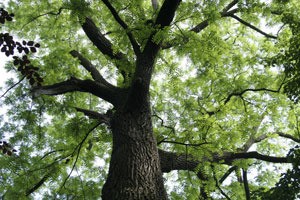 Highly prized for its strength, resistance to decay, handsome wood grain, and product versatility (it's made into everything from furniture to airplane propellers) to woodworkers, black walnut trees are considered black gold. To us gardeners, however, black walnut trees can prove to be a difficult landscaping challenge.
Highly prized for its strength, resistance to decay, handsome wood grain, and product versatility (it's made into everything from furniture to airplane propellers) to woodworkers, black walnut trees are considered black gold. To us gardeners, however, black walnut trees can prove to be a difficult landscaping challenge.
Allelopathic interactions are complex and scientists are still conducting studies to fully understand the process.
Create Some Distance: The roots of a large black walnut tree can extend far beyond the reaches of its canopy. There is no magic safe distance for planting, but suffice to say, the farther away the better. When in doubt, make sure you experiment with cheaper plants.
Growing In Containers: Many gardeners have found great success by growing susceptible plants above ground in attractive containers. This is your opportunity to get creative and experiment with different planters and containers.
Clean Up Tree Debris: Leaf litter and nut husks contain only very small concentrations of juglone, but it's better to play it safe than be sorry by keeping the area around your tree raked up and free from fallen debris. If trimmed branches or bark are shredded for mulch, be sure to use them only on juglone resistant plants.
Other susceptible plants include: Azalea, rhododendron, cotoneaster, potentilla, apple, blackberry, blueberry, cucumber, grapes (domestic), crocus, peony, black alder (Alnus); basswood; white birches; Hopa crabapple; hackberry; Amur honeysuckle; Japanese larch; lespedeza; lilac; saucer magnolia; silver maple; mountain laurel; loblolly pine; red pine; scotch pine; white pine; privet; Norway spruce; and alfalfa.
Vegetables
Lima beans; snap beans; beets; carrots; corn; onions; melons; parsnips; and squash.
Landscape Plants
Red cedar; crabapple*; elm; winged euonymus; forsythia; hawthorn; hemlock; hickories; black locust; maples (most species); oaks; autumn olive; pachysandra; paw paw; persimmon; wild rose; sycamore; most viburnums; and Virginia creeper.
Fruits
Cherries and black raspberries
Flowers and Herbaceous Plants
Astilbe; bee balm; wax begonia; bellflower; bloodroot; bluebells; Kentucky bluegrass; coral bells; cranesbill; crocus*' daffodil; Shasta daisy; daylily; Dutchman's britches; ferns; fescue; hollyhock; glory-of-the-snow; hosta; iris; Jack-in-the-pulpit; lamb's ear; liriope; lungwort; pansies; pot marigold; morning glory; narcissus; phlox; sedum; Siberian squill; snowdrop; spiderwort; spring beauty; sundrops; sweet woodruff; trillium; violets; and zinnia.
* Conflicting information available so it appears on both lists.
Here are the questions asked by community members. Read on to see the answers provided by the ThriftyFun community.
I want to plant ground cover in the area between the street and my sidewalk. It is under two black walnut trees. So I need something the can be stepped on and is able to handle the abuse of falling walnuts and squirrels.
By Ryan F.
Ivy, virginia creeper, and vinca do very well under my black walnut.
We have virginia creeper and myrtle under our black walnuts. They are thriving.
I just had a black walnut tree cut down and the stump ground down, can you tell me what tree I can plant in it's place that would flower in the spring or summer? Can I plant a crape myrtle tree?
Hardiness Zone: 7a
Peter Loewer (sp?) used to have a list of plants that will live under walnut trees on his website. You might google his name or "the wild gardener" and see if it is still there.
Good luck!
Incidentally, my extension agent just told me that walnut trees are an indicator of good soil and growing conditions. I didn't know that, but should mean that whatever you can get to grow on the site will have a good chance of doing well.
I want to plant a Virginia sweetspire. The area where I'm thinking of planting it has a black walnut tree in it. Does anyone know if the black walnut is toxic to Virginia sweetspires? Thanks in advance!
Hi there! Black walnuts are a real pain this way... I googled "juglone poisoning" and didn't get much. I've never really been able to get much from online articles on this. If you do find a website that seems to have definitive answers on what is tolerant and what isn't, you can click on another and find the complete opposite. Here's what I've done. Go ahead and plant it near the walnut- Wait a year (I know, this part is horrible) and see how it does by mid spring next year. What most places will tell you is that if it "fails to thrive", you should move it. The sweetspire shouldn't die. (I can't say won't die, but I'm 99% sure it won't) What will happen if it's susceptible to the juglone is that it will seem listless, and might not put out as much new growth, or it'll come back smaller than it was this year. The good news is that you can move it and it will recover nicely. This is all assuming you have another place you are willing to put it if this spot doesn't work out. And honestly, the only way I've been able to fully trust whether something can tolerate it or not is to try it. You shouldn't lose the plant, and you'll have a definite answer.
Funny story- The way I discovered this black walnut toxicity was when I planted a rhodie underneath one and it slowly died. I got onto my husband, accusing him of peeing on it (It was underneath a balcony and you know how guys are) and killing it with too much acid. He swore he didn't do it, so I was forced to look up alternative causes of death. :)
Does this apply to all kinds of walnuts, Manchurian walnut, Japanese walnut, and common walnut, too?
By Eric K